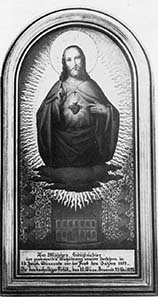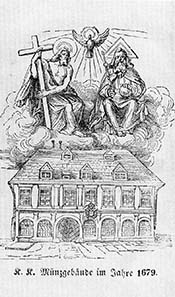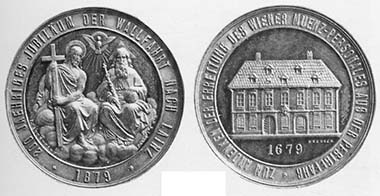The minters’ pilgrimage
He who visits the old church of Lainz may discover on close examination a rather unspectacular votive picture as one of thousands donated in the second half of the 19th century.
Votive picture depicting the Sacred Heart of Jesus, below the old building of the Vienna Mint in the Wollzeile.
The Sacred Heart of Jesus is shown, i.e. the bust of haloed Christ that allows a glimpse at the heart of the saviour lit by beams and encompassed by a crown of thorns. Pure unadulterated kitsch, most people may think at first and quickly walk away. But that would be a pity since there is something fascinating to discover below the bust.
The building of the Vienna Mint in the Wollzeile shown in a devotional book from 1850. Clearly visible are the windows on the bottom floor that were walled up in the year of the plague.
The building of the Vienna Mint in the Wollzeile is shown there. An inscription on a bar says „Zur 200jährigen Gedächtnisfeier der gnadenvollen Beschützung unserer Vorfahren im k. und k. Haupt-Münzamt vor der Pest des Jahres 1679. In dankschuldiger Pietät das kk. MünzPersonal. 25. Mai 1879.“ – “On the bicentenary of the protection of our ancestors of the k. und k. mint against the plague of 1679. With indebted reverence, the kk. mint staff. May 25th, 1879.”
The inscription leads us back into one of the most horrible years Vienna had to endure. The beautiful city was afflicted by the plague. Within a few months, more than 30.000 Viennese people died of that awful disease. A symbol of that time of fear became “dear Augustine”, an endearing and lightheaded person who, after a boozy night and assumed to be dead, was thrown onto a barrow carrying the corpses of those who had died of the plague. He was transported to one of the pits where he slept it off. The fact that he left the pit alive and well the following morning is recalled in the German song “Oh, du lieber Augustin, alles ist hin“ – “Augustine, dear Augustine, everything is gone”.
Medal on the anniversary of the pilgrimage in 1879.
No one of the staff of the Vienna Mint and their families died of the Plague. The vigorous mint master Mathias Mittermayer had made arrangements. On the first sign of the plague he turned his mint into a fortress or rather an isolation ward. He stored sufficient provisions and ordered all his employees and their families to entrench in the mint. The windows were walled up with only small holes to watch what was going on outside.
The minters held the fortress against the plague for nine months. Eventually, when the plague was defeated by the chilly autumnal climate, the entire mint staff and their families left the building safe and sound. They had been lucky. No one had been infected by the plague – otherwise, the fortress against death could have become a death trap.
Medal on the anniversary of the pilgrimage in 1979.
In any case, the saved were grateful. They vowed an annual pilgrimage to the church of Lainz that was consecrated to the Holy Trinity. That pilgrimage is undertaken until the present day – every year, on Trinity Sunday, the Sunday after Pentecost.












